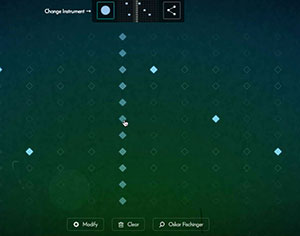MusicTech has recently released a beginners section for to those who are new to the audio recording. They thought it would be best to start with the central piece of any recording studio doing multi-track recording, the Digital Audio Workstation – better known as the DAW.
Trivia: DAW’s were once called sequencers: a component whether software or hardware that enables you to make tunes by sequencing or arranging notes. They were first made popular and possible by computers.
MIDI or Musical Digital Interface is what was and is still being used today to record many of those digital notes to your DAW’s to create sequences to your desire.
Here is the link to MusicTech’s guide to DAWs: http://www.musictech.net/2017/06/complete-guide-daws-part-1/
Archives for June 2017
Google Doodle Is A Sequencer Synth With 4 Instruments
 Today’s (June 22nd 2017) Google doodle is basically a sequencer, meaning there is a time grid that you can put musical notes onto that will play when the sequence comes to those notes.
Today’s (June 22nd 2017) Google doodle is basically a sequencer, meaning there is a time grid that you can put musical notes onto that will play when the sequence comes to those notes.
The doodle is a fun musical toy. You get 4 instruments, one sounds like piano and the other three sound like bells of various sizes and shapes. And you get a large grid. You use your mouse to put a tick on any spot. Then a cursor moves left to right across the grid. As it reaches the spots where you’ve put a tick, it sounds.
You can make chords or melodies or both. Once you’ve putin some notes for one instrument sound, you can change the instrument. Your original notes aren’t visible anymore because the fresh grid allows you to put marks in the same note-time grid point. The original notes do continue to play though. So as they do, you place new notes/chords with the new instrument and both will play at the appropriate time (when the cursor reaches them).
Repeat the process for the 3rd and 4th instrument and you can create something pretty darned cool.
The doodle was to celebrate Oskar Fischinger’s 117th birthday.
Who was Oskar Fischinger? He was an artist. One of the things he loved to do was combine music with his art, making musical animations. He did not invent the sequencer:-P. It just so happens that using a synthesizer-type sequencer like this, you can create musical animations like Oskar Fischinger’s.
You can only play the synth on the normal Google page today (June 22nd, 2017). So go play. If you’re reading this after the 22nd, go here to check it out: https://www.google.com/doodles
If you want to read more about Oskar Fischinger, click here.
Switching DAW's While Recording; A Big No!
Graham Cochrane of recordingrevolution.com in this video proves that switching DAWs while recording is not just a metaphor (get it – switching horses in the middle of the stream…no? OK, nevermind :-P), but can really affect your recordings in a bad way.
BTW, if you are wondering what a DAW is, check out my post What Is A DAW? It Means Digital Audio Workstation.
Graham has 8 years+ experience not just recording, but creating videos as well. Graham answers questions here from from beginners and professionals about how switching from one recording software to a totally different one may hurt your output.
Why would anyone switch DAWs anyway? Well, it almost always has to do with what my wife calls the “ooo, shiny” syndrome. Someone starts a project in one program, and then hears about a new and “better” program.
Watch full video here: https://www.recordingrevolution.com/switching-daws-can-ruin-your-recordings/
Reason 9.5 By Propellerhead
Reason, Propellerhead’s DAW, has just released version 9.5 to support the demand of its followers who wanted several new features. It was slow in coming, but Propellerhead finally acceded to some user demands in 9.5. For one thing, it finally has support for VST instruments!
MusicTech calls Reason “the best environments for music making.” And now you can use your favorite 3rd-party VST instruments in that environment. This is huge news!
This version is free for Reason 9 users as a simple 200MB download. Once opened Reason 9.5 immediately scans for VST to implement your collection take note this process takes only a few minutes and you are good to go. Simply drag all instruments to the Reason Rack although appearing standard once you click then the actual instrument appears.
Read more here: http://www.musictech.net/2017/06/reason-9-5-review/
A Review Of MOK Waverazor Synthsizer
Waverazor is a synthesizer. As it says in the review, you put in MIDI notes, and Waverazor plays a sound.
It is software synth (as opposed to a piece of standalone hardware like in the old days), available as a 32-bit and/or 64-bit plugin for Windows and Mac systems.
Check out this video:
It offers a unique continuous modulation of various parameters in each waveform slice that can be very useful for evolving sounds. A lot of the sounds that can be made with Waverazor will remind you of 70’s to 90’s manipulated sounds.
It offers old and a few new options, but is it worth buying?
Read about the verdict here: http://bedroomproducersblog.com/2017/06/11/waverazor-review/